Craving a soft, warm, and foldable tortilla wrap that doesn’t taste like cardboard? You’re in the right place! This article spills all the secrets to creating the perfect tortilla wrap recipe right in your kitchen—no fancy gear needed. Whether you’re a newbie or a seasoned home cook, you’ll learn how to make soft flour tortillas, choose the right ingredients, master the rolling and cooking process, and even discover what tasty fillings to use.
We’ll also answer burning questions like, “What flour makes the softest tortillas?” and “How do I keep wraps from cracking?” Stick around for pro tips, storage hacks, creative filling ideas, and more. Let’s dive into this flavorful journey—your go-to tortilla wrap recipe awaits!
Table of Contents
Introduction to the Tortilla Wrap Recipe
What is a Tortilla Wrap Recipe and Why Make It at Home?
A tortilla wrap recipe is simply a guide to making pliable, thin flatbreads—perfect for rolling around your favorite fillings like grilled chicken, sautéed veggies, or creamy hummus. But here’s the kicker: homemade wraps blow store-bought ones out of the water. Why? Because fresh tortillas are soft, warm, and free from preservatives that make packaged versions stiff or rubbery.
Plus, when you make them yourself, you control the ingredients—no mystery additives. They cook in minutes, and you’ll be amazed by how versatile they are. Breakfast burritos, lunch wraps, light dinners… the list goes on!
Benefits of Homemade Tortilla Wraps Over Store-Bought
There’s nothing like that first bite of a homemade tortilla wrap. The edges are slightly crisp, the middle stays chewy, and the flavor? Oh, it’s fresh and subtly nutty from the flour. Unlike supermarket tortillas that can be tough or dry, DIY wraps are tender and flexible—perfect for folding without cracking.
Also, you save money and reduce waste. No more tossing out expired tortillas or half-used packs. With this tortilla wrap recipe, you’ll make just what you need and keep things tasty and simple. Whether you’re meal prepping or cooking on the fly, homemade is the way to wrap it up!
Essential Ingredients for a Perfect Tortilla Wrap Recipe
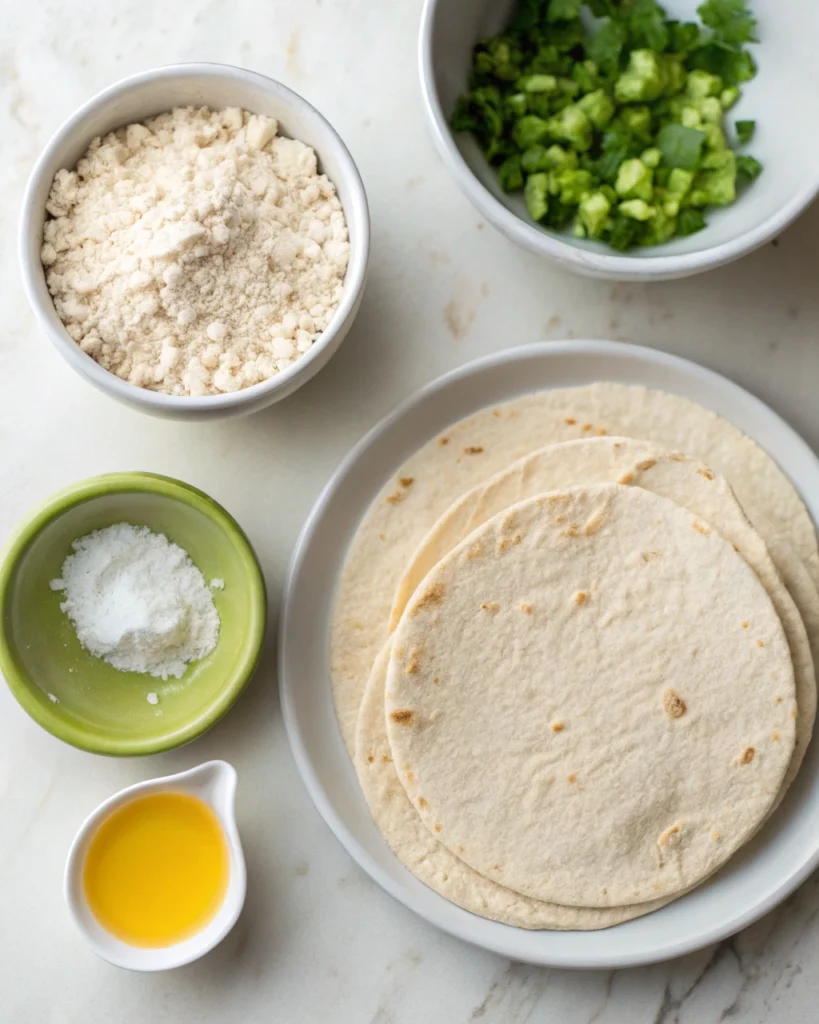
The Core Components: Flour, Water, Salt, and Fat
Believe it or not, the best tortilla wrap recipe only needs four basic ingredients—flour, water, salt, and fat. That’s it! No chemicals, no preservatives, just wholesome pantry staples that you likely already have at home. Let’s break them down:
Flour: This is your main player. Most recipes call for all-purpose flour, which gives a nice balance of softness and structure. It’s the go-to for a reason—it works.
Water: Warm water helps activate the gluten in the flour, which creates those delightfully chewy layers. If your dough feels dry, don’t be afraid to add a little more water gradually.
Salt: This might seem small, but salt adds depth. Dissolve it in warm water before mixing it into your flour to make sure the flavor spreads evenly.
Fat: Oil, butter, or even melted ghee can make a world of difference. They help keep your tortilla pliable and soft instead of cracking when you roll it.
Some recipes toss in a pinch of baking powder, but honestly, it’s optional. It can create air pockets, but the texture’s still wonderful without it. You can check out this Bon Appétit flour tortilla guide for more tips on getting the dough just right.
Choosing the Best Flour for Soft and Pliable Tortillas
Picking the right flour is where the magic starts. While all-purpose flour is super reliable, others bring unique perks to the table. For instance, bread flour gives slightly chewier tortillas due to its higher protein content. If you’re after a slightly nuttier flavor and added fiber, whole wheat flour is a solid choice—but it may need a splash more water.
Want to go gluten-free? Consider using a blend made for gluten-free baking, though results can vary. Some blends may require xanthan gum or other binders to hold the dough together. According to The Kitchn’s tortilla recipe, sticking to traditional flours ensures better softness and flexibility, especially for rolling wraps without tearing.
In short, test what works best for you—but if in doubt, start with all-purpose flour. It’s what most winning tortilla wrap recipes use, and it won’t let you down.
Step-by-Step Tortilla Wrap Recipe Guide
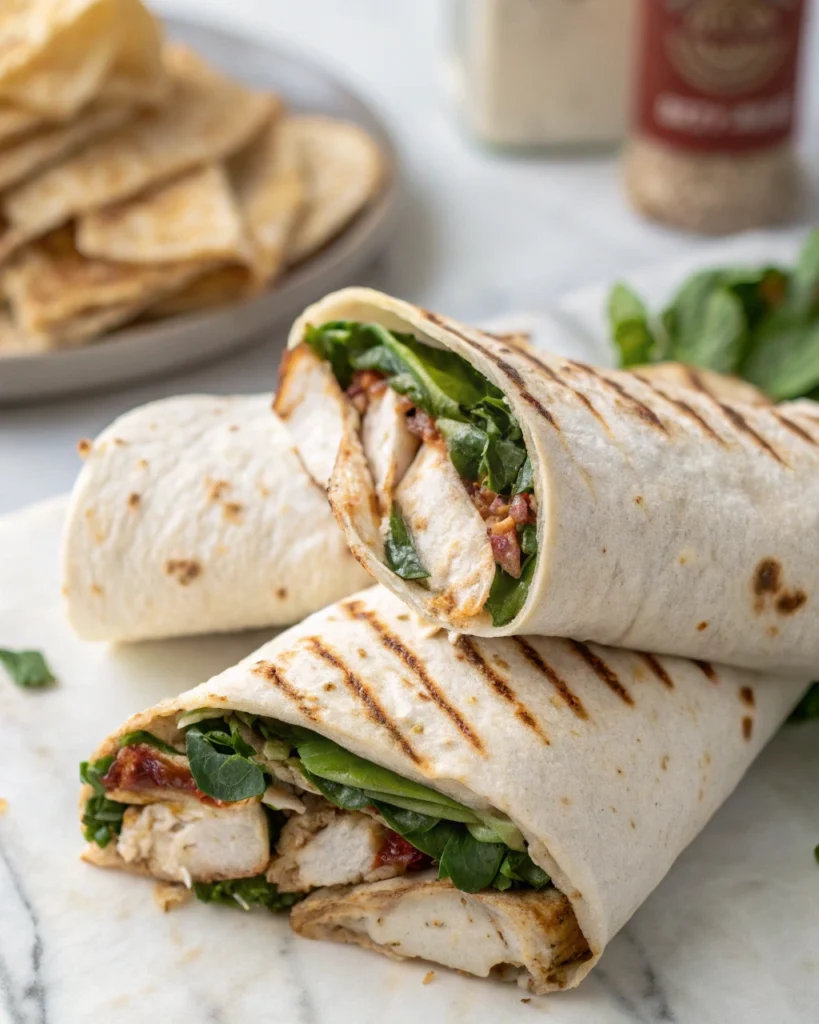
Making the Dough from Scratch: Mixing and Kneading Tips
Okay, you’ve got your ingredients—now let’s bring them to life. Start by mixing flour and fat (like oil or melted butter) in a bowl. Use a fork or your fingers until the mixture looks crumbly. Next, pour in your salted warm water a little at a time. Stir until a shaggy dough forms—don’t worry if it’s not perfectly smooth yet.
Then comes the fun part: kneading. On a lightly floured surface, knead the dough for about 3 minutes until it turns soft and smooth. If it feels sticky, sprinkle in a little more flour. If it’s too dry, add a teaspoon of water. Trust the process—the dough gets more elastic as you work it.
Resting the Dough for Easy Rolling
This step is often skipped, but it’s a game-changer. Let the dough rest for at least 15 to 30 minutes, covered with a clean towel. Resting relaxes the gluten, making it way easier to roll out thin without snapping back. The result? Super flexible tortillas that won’t tear when filled or folded.
Rolling the Dough into Thin Rounds: Techniques for Consistency
After resting, divide your dough into equal balls—usually 8 to 10 for medium-sized wraps. Use a rolling pin to flatten each ball into an 8-inch circle. Don’t stress about perfect circles; even the wonky ones taste great. The trick is to roll them as thin as you can without tearing.
To keep them from sticking, dust both the rolling surface and your dough with a bit of flour. If you want extra finesse, stack the rolled-out tortillas with parchment paper between each one before cooking.
Cooking the Tortillas: Pan Heat, Timing, and Texture Clues
Heat a cast-iron skillet or nonstick pan over medium-high heat. Once hot, toss in your first tortilla. Within 20–30 seconds, it should start to bubble and puff. Flip it once you see golden spots on the bottom—don’t wait too long or it might dry out.
The second side cooks faster—just 20 seconds or so. Once both sides are spotty and cooked, transfer it to a clean dish towel to keep warm and soft. Repeat with the rest. Keep them stacked and covered so they stay steamy and flexible—perfect for any tortilla wrap recipe you whip up later.
And there you have it—fresh, soft tortillas made right in your own kitchen. They’re ready to be filled, folded, and devoured!
Storage and Reheating Tips for Homemade Tortilla Wraps
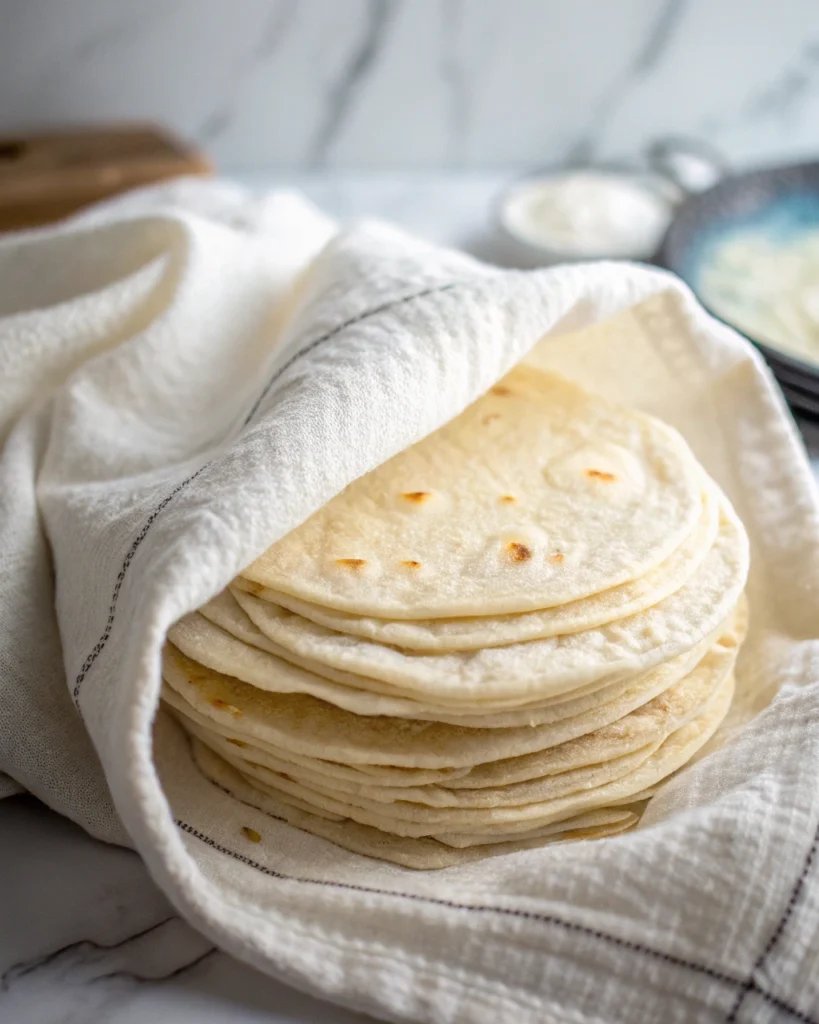
How to Store Fresh Tortillas Without Losing Softness
You’ve just nailed the perfect tortilla wrap recipe—but now what? Don’t let those tender wraps turn into stiff cardboard. First things first, let them cool slightly, then stack them while they’re still warm. Wrap them in a clean dish towel to trap steam, which helps keep them soft and pliable.
Once cool, transfer them to an airtight container or a resealable plastic bag. Store at room temperature if you’ll use them within a day or two. Otherwise, the fridge is your friend—just make sure they’re sealed tight to avoid drying out. Oh, and always separate each tortilla with parchment paper if stacking. That way, you won’t peel one and bring half of another with it!
Freezing Homemade Tortillas: Do’s and Don’ts
Want to batch-cook and freeze? Absolutely doable! Just stack your cooled tortillas with a small square of parchment paper between each one. Pop the stack into a freezer-safe bag, press out the air, and seal it well. They’ll keep their magic for up to 3 months.
To thaw, place them in the fridge overnight or let them sit on the counter for an hour or so. Whatever you do, avoid microwaving from frozen—it’ll zap the texture and turn them rubbery. Instead, reheat on a dry skillet for 30 seconds per side to bring back that delightful softness. Trust us, your tortilla wrap recipe deserves nothing less.
For more delicious recipes, check out our article on cottage cheese wraps—a great alternative for healthy filling ideas!
Filling Ideas for Your Tortilla Wrap Recipe
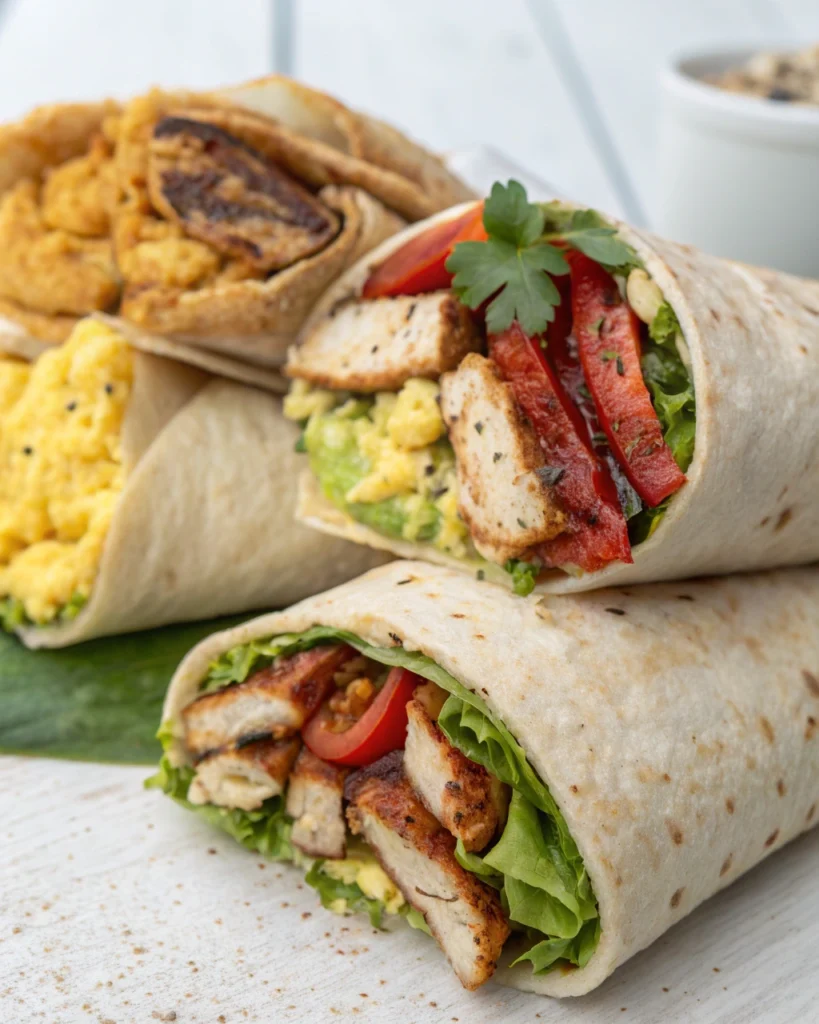
Breakfast Wraps: Eggs, Veggies, and Mild Sauces
Mornings get a whole lot better when your first bite includes a warm, hearty tortilla. Start with scrambled eggs, then add sautéed bell peppers, spinach, and maybe a sprinkle of cheese. Want a bit of kick? A drizzle of salsa or a spoon of guacamole works wonders.
Breakfast wraps aren’t just fast—they’re totally customizable. You could even use yesterday’s leftover roasted veggies. With a reliable tortilla wrap recipe, you’ve got a canvas for whatever flavors you crave at dawn. And hey, they’re portable, so no excuses to skip breakfast anymore!
Lunch & Dinner Options: Grilled Chicken, Veggie Mixes, Beans
When lunch or dinner rolls around, the possibilities only grow. For protein-packed wraps, toss in grilled chicken, beef strips, or chickpeas. Pair with fresh lettuce, tomatoes, cucumber, and a creamy yogurt-based sauce or tahini dressing. Oh, and don’t forget the crunch—shredded cabbage or toasted seeds are game-changers.
Looking for something meat-free? Try hummus, roasted sweet potatoes, or lentils. These fillings are not only satisfying but also packed with flavor and nutrients. That’s the beauty of a good tortilla wrap recipe: it adapts to whatever ingredients you’ve got on hand.
Need more ideas? Explore our easy lunch wraps in the gluten-free lunch ideas section at SERecipes!
Whether it’s a quick weekday lunch or a cozy family dinner, the humble tortilla wrap can be your flavor-packed solution. Just roll, fold, and enjoy!
Common Variations of the Tortilla Wrap Recipe
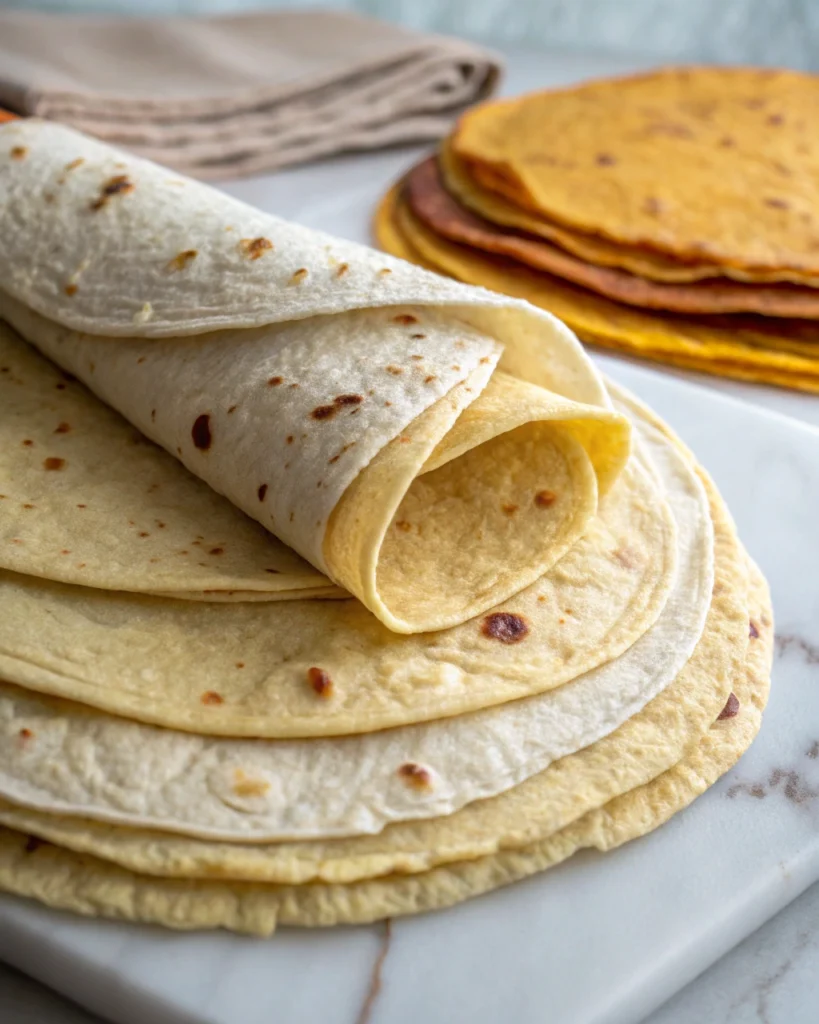
Whole Wheat, Gluten-Free, and Vegan Tortilla Options
If you’re looking to tweak your tortilla wrap recipe to fit a special diet, you’re in luck. There are plenty of ways to switch things up without losing that soft, delicious texture. For a healthier twist, swap out all-purpose flour with whole wheat flour. It adds fiber and a nutty flavor, though you might need a splash more water to keep the dough from getting too stiff.
Going gluten-free? Try a gluten-free flour blend that’s made for baking. Many come with xanthan gum already mixed in, which helps hold the dough together. Keep in mind, though, that gluten-free dough can be a bit tricky to roll and cook. Patience is key! And if you’re aiming for a vegan version, use vegetable oil or melted coconut oil instead of butter or ghee. The end result is still soft, pliable, and totally wrap-worthy.
These variations make the tortilla wrap recipe work for everyone at the table—because no one should miss out on something this good.
Adding Herbs and Spices to the Dough for Flavorful Twists
Want to add a little excitement to your wraps? Mix herbs or spices directly into your dough before kneading. A pinch of garlic powder or cumin can give your tortillas a savory edge. Or toss in finely chopped cilantro or dried oregano for an herbal lift.
For a warm and earthy flavor, smoked paprika or turmeric adds both color and depth. The beauty of this approach is that you can customize each batch to match the theme of your meal. Planning a Mediterranean-style wrap? Add a little rosemary or basil. Going for Mexican vibes? Chipotle powder or chili flakes will do the trick.
Little tweaks like these turn a basic tortilla wrap recipe into something truly special—and endlessly fun to experiment with.
Mistakes to Avoid When Making a Tortilla Wrap Recipe
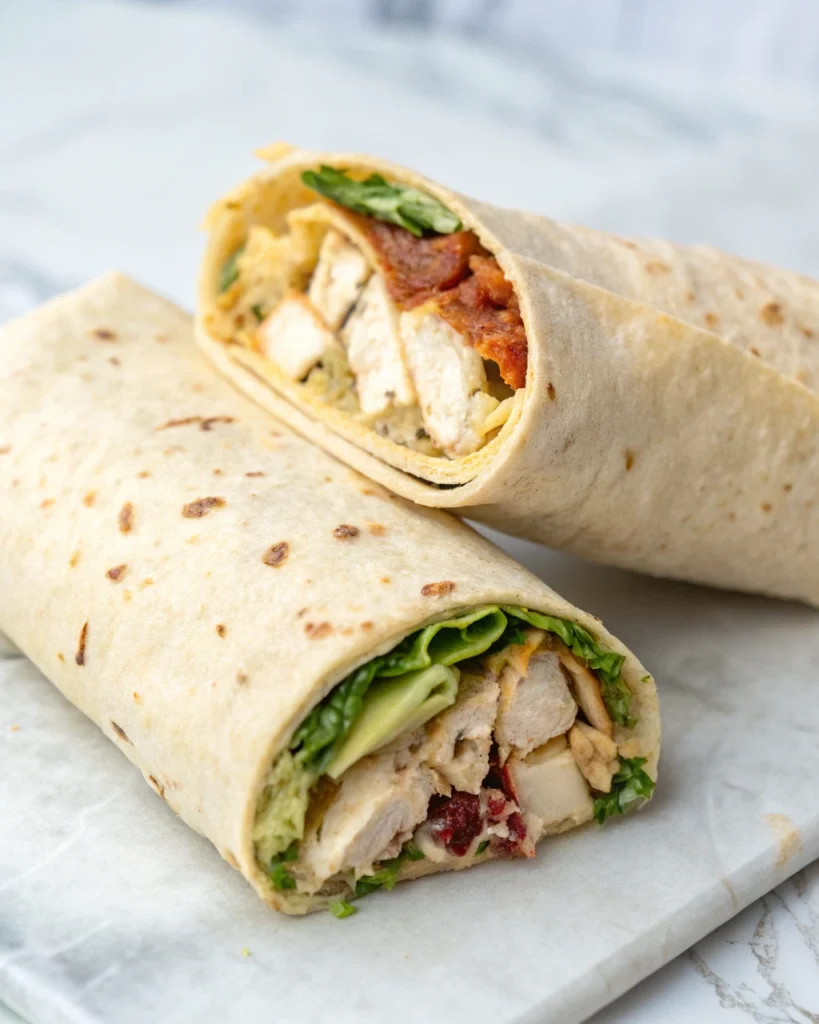
Overcooking or Undercooking the Wraps
Let’s be honest—it’s easy to go from perfectly golden to dry and brittle in seconds. If your heat is too high, tortillas can brown too fast and lose that soft bite. Too low, and they’ll stay pale and rubbery. So what’s the sweet spot? Medium-high heat works best. The tortilla should puff slightly and get golden spots within 30 seconds. If it takes longer, turn up the heat just a touch.
And don’t walk away! These cook fast, and timing is everything. With practice, you’ll know exactly when to flip and when to pull them off the pan. That’s the difference between an okay wrap and a “Wow, did you make this?!” moment.
Dough Too Thick or Too Dry
Another common hiccup is rolling the dough too thick. Thick tortillas can be tough and doughy—not ideal for wrapping. Roll them thin, about 1/8 inch or less. You want them to bend, not break.
Also, if your dough is too dry, the wraps may crack when cooked. Add water a little at a time while kneading until the dough feels smooth and soft—not sticky, but not stiff either. Resting the dough helps too. It relaxes the gluten, making rolling and cooking easier.
A few small fixes go a long way. When you avoid these mistakes, your tortilla wrap recipe delivers every time—soft, foldable, and full of flavor.
FAQs
How do I make my own tortilla wraps?
Making your own wraps is surprisingly easy! You only need flour, warm water, salt, and a bit of oil. Mix them into a dough, knead it until smooth, let it rest, then roll and cook each one on a hot skillet. That’s it! The key is keeping the dough soft and rolling it thin so each wrap is flexible. With this simple tortilla wrap recipe, you’ll never go back to store-bought again.
What are the ingredients for tortillas?
The most common ingredients are all-purpose flour, warm water, salt, and a neutral oil like canola or olive oil. Some people also add baking powder, but it’s optional. The ingredients are simple, but the flavor and texture depend on the balance between them—and a little love in the kneading process!
What’s the difference between a wrap and a tortilla wrap?
Great question! A “wrap” usually refers to the final product—a rolled-up meal filled with ingredients like veggies, protein, or sauces. A “tortilla wrap” specifically uses a soft flour tortilla as the outer layer. So, while all tortilla wraps are wraps, not all wraps are made with tortillas. Got it? Awesome!
What makes flour tortillas soft and fluffy?
It’s all about the dough. Warm water helps the gluten develop evenly, and oil keeps things tender. Letting the dough rest before rolling is also a game-changer. And during cooking, don’t overdo it—just enough time to get golden spots without drying it out. These tips ensure your tortilla wrap recipe comes out soft and foldable every time.
What flour is best for tortillas?
All-purpose flour is the go-to. It creates a soft yet sturdy texture that’s perfect for wrapping. If you want a healthier twist, you can use whole wheat, though the texture might be slightly denser. For best results, stick to flours with medium gluten content. That way, the tortillas stay flexible and flavorful.
What to put in a tortilla wrap?
The sky’s the limit! You can stuff your wrap with grilled chicken, beans, sautéed veggies, scrambled eggs, tuna salad—you name it. Add leafy greens, sauces, or even cheese for extra flavor and texture. The beauty of a great tortilla wrap recipe is how easily it adapts to whatever you’re craving.
Conclusion: Mastering the Art of the Perfect Tortilla Wrap Recipe
There you have it—everything you need to master a foolproof tortilla wrap recipe from start to finish. From selecting the right ingredients to rolling, cooking, and even storing, it’s clear that making homemade wraps isn’t just doable—it’s downright fun.
Whether you’re crafting a quick breakfast wrap or preparing a hearty dinner roll-up, fresh tortillas take things to a whole new level. With a little practice, your wraps will be soft, tasty, and ready to impress. So grab that rolling pin, heat up your skillet, and start creating wraps worth bragging about!
Print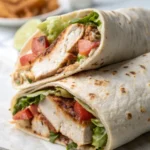
Tortilla Wrap Recipe
- Total Time: 40 minutes
- Yield: 10 tortillas
Description
This soft and simple tortilla wrap recipe uses just a few ingredients to create warm, foldable wraps perfect for breakfast, lunch, or dinner. Whether filled with eggs, veggies, or grilled meat, these homemade tortillas are flexible, delicious, and far better than store-bought!
Ingredients
– 2 cups all-purpose flour
– 1 teaspoon fine sea salt
– 2/3 cup very warm water
– 5 tablespoons vegetable oil (or melted butter)
Instructions
1. In a small bowl, dissolve the salt in warm water and set aside.
2. In a large mixing bowl, combine flour and oil until crumbly.
3. Gradually add the salty water and stir until a shaggy dough forms.
4. Knead the dough on a floured surface for 2–3 minutes until smooth.
5. Cover the dough and let it rest for at least 15–30 minutes.
6. Divide the dough into 10 equal balls and roll each into a thin 8-inch circle.
7. Heat a dry skillet over medium-high heat.
8. Cook each tortilla for 30–60 seconds per side until golden spots appear.
9. Stack cooked tortillas in a towel to keep warm and soft.
- Prep Time: 30 minutes
- Cook Time: 10 minutes
- Category: Bread, Wraps
- Cuisine: Mexican, Mediterranean, American
Nutrition
- Calories: 92 kcal
Keywords: tortilla wrap recipe, homemade tortillas, easy wraps, flour tortillas, soft wraps, lunch wraps
Did you make this recipe?
There are no reviews yet. Be the first one to write one.

